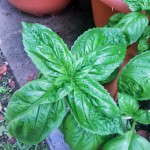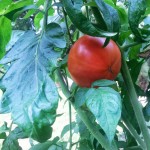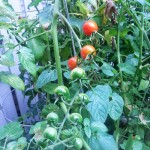Time flew! I’ve been picking tomatoes and taking stock of my work.
Where I am today
We’ve enjoyed lettuce, chard, basil, and cherry tomatoes. The cherry tomatoes thus far have been a revelation. Having a steady supply right outside my door is a real treat — even my daughter agrees. My Jersey tomatoes started ripening this weekend. I’m still waiting on my PInk Brandywines. My pea plants never made it (started too late and I tried transplanting, a mistake). The shoots at least tasted nice. I didn’t have room for other plants due to the overabundance of tomato plants. This is my other main fail. Overall I’m happy thus far and am optimistic about a potentially large tomato harvest, which would make the season for me. Let’s call it a solid B for now.
Success with drip irrigation
As a matter of technique, this system has been the major success of the year. It’s been reliable, water-conserving, and labor-saving. I’ve promised my mom I’ll set something up for her at the beginning of next season. I realize I still owe a post on how, specifically, I set it up. I’ll defer this to next week.
Achieving balance
This year I followed the rule “Grow what you like.” Unfortunately I took it to an extreme without thinking ahead. About half of my containers are dedicated to tomato plants. Tomatoes take a long time to grow. Seeds need to be started. Then plants have to be hardened off. Then once they are planted, they need at least 70 days of growing before they are ready to set fruit. Then the fruit has to grow. Finally, the fruit must ripen. Only after that can a tomato be picked. Since I devoted so much space to tomato plants and didn’t plant my greens with sufficient density, the majority of my (expected) yield is only coming in now.
The lesson for next year is to set aside a higher share of my planting area for salad greens like lettuce, mustard, and herbs to be harvested as microgreens; cooking greens like spinach, chard, kale, and collards; and other vegetables like peas and beans. Next year I may split (in percentage terms) my space across these categories and tomatoes, respectively, along the lines of 20-20-20-40. And variety is also a function of activity. I didn’t succession plant, e.g. plant something after I removed my failed peas, or plant companions, save for growing basil among the tomatoes.
Proper planting density
I probably goofed. I’m certain on this with the greens and very suspicious when it comes to the tomatoes.
I think I underplanted my lettuce and chard. The gardener’s logic is that lettuce and chard don’t need deep roots and only the greens are of interest. This means that lettuce should be planted more densely than other plants, especially for the cut-and-come-again varieties I was growing. (To cut and come again means taking what you need from the plant — cutting leaves very close to the soil — and coming back once the plant has sent up new growth.) Since we’re entering the second shoulder season (spring and fall are the cold “shoulders” of the growing year), I will give these vegetables another round, planting at much higher densities.
In contrast, I may have overplanted some of my tomatoes. To my (potentially great) shame I have three tomato plants per container in three containers. Tomatoes are resource-intensive. To generate quality fruits they need a lot of water, a lot of sun, and a lot of food. The gardener’s logic is that competition hurts these plants more than others. Plants compete under the soil with their roots and in the air with their branches. The more resources tomato plants put into these, the less they have for fruits. Thankfully I didn’t crowd all my tomato plants. Furthermore it does look like they’re producing. Next year I’m going to be much more thoughtful about how I plant these.
Cages and supports
My tomato plants have completely overrun my garden. Recall, this is how the garden used to look.
The tomatoes keep looking for room to grow. I’m not sure what to make of this. Is this growth desirable? Are they diverting away resources to green growth due to competition? It’s hard to know. What I do know is that I’m going to be prepared next year. Next year I’d like to incorporate some of the caging techniques from the video below.
The wire roll the guy uses seems low-hassle, economical, and adaptible to containers. We’ll see.





